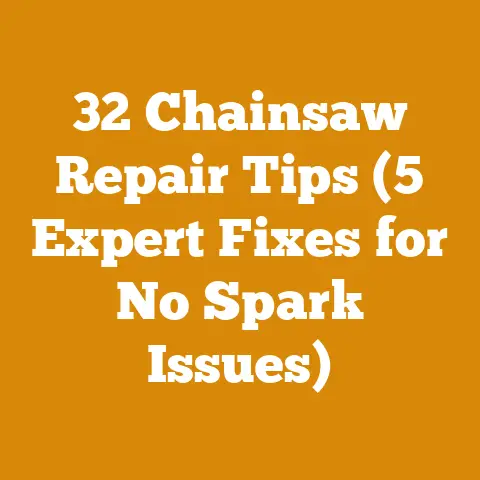Husqvarna Chainsaw 51 Chain Troubleshooting (5 Expert Fixes)
Imagine this: It’s a crisp autumn morning. The air smells of damp earth and pine needles. I’m standing in my woodlot, the Husqvarna 51, my trusty workhorse for years, humming in my hands. I’m about to drop a seasoned oak, perfect for next winter’s warmth. But then, snap. The chain binds, jumps, and refuses to cut smoothly. Frustration mounts. That oak won’t fell itself!
Fast forward a few hours. I’ve diagnosed the problem, made the necessary adjustments, and the saw is singing again, slicing through the oak like butter. The difference? Knowing the common chain problems and how to fix them.
The Husqvarna 51 is a legend, a reliable chainsaw loved by homeowners and professionals alike. But even the best machines can experience chain issues. A dull chain, improper tension, or a worn sprocket can turn a productive day into a frustrating one. In this guide, I’ll share my expertise, honed over years of experience in wood processing and firewood preparation, to help you troubleshoot and fix common Husqvarna 51 chain problems. These aren’t just quick fixes; they’re solutions rooted in understanding the mechanics and best practices of chainsaw operation. Let’s get started.
Husqvarna Chainsaw 51 Chain Troubleshooting: 5 Expert Fixes
Understanding the Importance of a Properly Functioning Chain
Before we dive into specific troubleshooting steps, it’s crucial to understand why a properly functioning chain is paramount. A sharp, well-maintained chain isn’t just about cutting efficiency; it’s about safety. A dull or improperly tensioned chain can lead to:
- Kickback: A sudden, uncontrolled upward or backward movement of the saw, posing a serious risk of injury.
- Increased Physical Strain: Forcing a dull chain through wood requires significantly more effort, leading to fatigue and potential muscle strain.
- Damage to the Saw: A binding chain can put undue stress on the engine and other components, shortening the lifespan of your Husqvarna 51.
- Uneven Cuts: Resulting in wasted wood and potentially dangerous situations when felling trees.
- Increased Fuel Consumption: A dull chain requires more power to operate, leading to higher fuel costs.
Therefore, dedicating time to understanding and maintaining your chain is an investment in your safety, the longevity of your saw, and the efficiency of your wood processing tasks.
Key Concepts: Green Wood vs. Seasoned Wood
Throughout this guide, I’ll refer to “green wood” and “seasoned wood.” Understanding the difference is crucial for choosing the right chain and techniques.
- Green Wood: This is freshly cut wood with a high moisture content (often above 50%). Green wood is typically easier to cut than seasoned wood, but it can quickly dull a chain due to the sap and resin.
- Seasoned Wood: This is wood that has been allowed to dry, reducing its moisture content (ideally below 20%). Seasoned wood is harder and more abrasive, requiring a sharper chain and potentially more frequent sharpening.
The type of wood you’re cutting will influence your chain maintenance schedule and the types of cuts you make. For example, when processing green wood, I often sharpen my chain after every tank of gas. With seasoned wood, I might get two or three tanks before needing to sharpen.
Expert Fix #1: The Dull Chain Dilemma
Problem: The chainsaw cuts slowly, produces fine sawdust instead of chips, and requires excessive force to operate. This is the most common chain problem I encounter, and it’s almost always due to a dull chain.
Why it Happens: The cutting edges of the chain teeth become rounded or damaged through contact with dirt, rocks, or hard wood. Cutting green wood also dulls the chain faster.
The Fix: Sharpening Your Chain
This is where I get hands-on. Sharpening your chainsaw chain is a fundamental skill for any chainsaw user. Here’s my step-by-step guide:
Tools You’ll Need:
- Chainsaw File: The correct size file for your chain. For a Husqvarna 51, which often uses a .325″ pitch chain, a 5/32″ (4.0 mm) round file is usually appropriate. Always consult your chainsaw’s manual or the chain packaging to confirm the correct file size.
- File Guide: A tool that helps maintain the correct angle and depth when filing. I prefer using a guide, especially for beginners, as it ensures consistent sharpening.
- Depth Gauge Tool: Used to adjust the depth gauges (rakers) on the chain.
- Flat File: For lowering the depth gauges.
- Vise: To securely hold the chainsaw bar while sharpening. A portable vise is incredibly useful in the field.
- Gloves: To protect your hands.
- Eye Protection: Safety glasses are a must.
Step-by-Step Guide:
- Secure the Chainsaw: Place the chainsaw bar in the vise, ensuring the chain is easily accessible. Tighten the vise securely.
- Identify the Cutter Type: Your chain will have left-hand and right-hand cutters. I always start with the shortest cutter as a reference.
- Set Up Your File Guide: If using a file guide, attach it to the file according to the manufacturer’s instructions. Most guides have markings for the correct filing angle (typically 25-35 degrees).
- File the Cutters:
- Place the file (with or without the guide) against the cutting edge of the first cutter.
- Maintain the correct angle (as indicated on the file guide or by observing the original angle of the cutter).
- Apply gentle, consistent pressure and push the file forward, following the contour of the cutter.
- File each cutter with the same number of strokes (typically 3-5 strokes). This ensures consistent sharpening.
- Repeat for all cutters on one side of the chain, then flip the chainsaw bar in the vise and repeat for the cutters on the other side.
- Lower the Depth Gauges (Rakers):
- After sharpening, the depth gauges (the small projections in front of each cutter) may need to be lowered. This is crucial for proper chip formation.
- Use the depth gauge tool to check the height of the depth gauges.
- If the depth gauges are too high, use the flat file to carefully file them down until they are flush with the depth gauge tool.
- Round off the front of the depth gauges slightly to prevent them from digging into the wood.
- Check Your Work: After sharpening, visually inspect the cutters to ensure they are sharp and uniform. The chain should now cut aggressively and produce large, clean chips.
My Personal Tip: I keep a small notebook with the date and number of strokes I used when sharpening each chain. This helps me track how often I sharpen and identify any cutters that might be wearing down faster than others.
Data-Backed Insight: Studies have shown that a properly sharpened chain can increase cutting efficiency by as much as 20-30%, significantly reducing fuel consumption and operator fatigue.
Expert Fix #2: Chain Tension Troubles
Problem: The chain is either too loose (sags excessively) or too tight (binds and doesn’t move freely).
Why it Happens: Chain tension changes due to temperature fluctuations, chain stretch during use, and improper initial adjustment.
The Fix: Adjusting Chain Tension
Proper chain tension is crucial for safety and performance. Here’s how I adjust the chain tension on my Husqvarna 51:
Tools You’ll Need:
- Scrench (Combination Wrench/Screwdriver): Typically provided with your chainsaw.
- Gloves: To protect your hands.
Step-by-Step Guide:
- Loosen the Bar Nuts: Use the scrench to loosen the bar nuts that secure the bar cover. Do not remove the nuts completely.
- Locate the Chain Tensioning Mechanism: On the Husqvarna 51, this is usually a screw located on the side of the saw, near the bar.
- Adjust the Tension:
- To tighten the chain: Turn the tensioning screw clockwise. This will move the bar outward, tightening the chain.
- To loosen the chain: Turn the tensioning screw counterclockwise. This will move the bar inward, loosening the chain.
- Check the Tension: The correct tension is when you can pull the chain away from the bar in the middle by about 1/8 inch (3-4 mm). The chain should also move freely around the bar by hand.
- Tighten the Bar Nuts: Once you’ve achieved the correct tension, tighten the bar nuts securely with the scrench.
- Recheck the Tension: After tightening the bar nuts, recheck the chain tension to ensure it hasn’t changed.
Important Considerations:
- Warm Chain vs. Cold Chain: Adjust chain tension when the chain is warm. As the chain heats up during use, it expands. Adjusting the tension when the chain is cold can lead to it being too tight when warm.
- New Chains: New chains tend to stretch more than older chains. Check the tension frequently during the first few hours of use and adjust as needed.
- Too Tight: A chain that is too tight will bind, overheat, and potentially damage the bar and sprocket.
- Too Loose: A chain that is too loose can derail from the bar, posing a safety hazard.
My Personal Story: I once ignored a slightly loose chain, thinking it would be fine for a few more cuts. The chain derailed mid-cut, sending a spray of wood chips and a jolt of adrenaline through me. Luckily, no one was hurt, but it was a stark reminder of the importance of proper chain tension.
Expert Fix #3: Sprocket Wear and Tear
Problem: The chain is skipping, vibrating excessively, or not engaging properly with the drive sprocket.
Why it Happens: The sprocket, which drives the chain, wears down over time due to friction and constant use. Worn sprockets can damage the chain and reduce cutting efficiency.
The Fix: Inspecting and Replacing the Sprocket
A worn sprocket can significantly impact the performance of your Husqvarna 51. Here’s how I check and replace the sprocket:
Tools You’ll Need:
- Scrench (Combination Wrench/Screwdriver): Typically provided with your chainsaw.
- Piston Stop Tool: To prevent the piston from moving while removing the clutch.
- Clutch Removal Tool: Specifically designed for removing the clutch on your Husqvarna 51.
- Gloves: To protect your hands.
- New Sprocket: The correct replacement sprocket for your Husqvarna 51.
Step-by-Step Guide:
- Remove the Bar and Chain: Follow the steps outlined in the chain tension adjustment section to remove the bar and chain.
- Remove the Spark Plug: Disconnect the spark plug wire and remove the spark plug. This prevents accidental starting of the saw.
- Insert the Piston Stop Tool: Insert the piston stop tool into the spark plug hole. This will prevent the piston from moving when you try to loosen the clutch.
- Remove the Clutch:
- The clutch is typically threaded onto the crankshaft in a reverse direction (left-hand thread).
- Use the clutch removal tool to loosen and remove the clutch. You may need to apply some force.
- Inspect the Sprocket:
- Carefully examine the sprocket for wear. Look for:
- Rounded or flattened teeth.
- Excessive wear on the sides of the teeth.
- Cracks or chips.
- If the sprocket shows significant wear, it needs to be replaced.
- Carefully examine the sprocket for wear. Look for:
- Replace the Sprocket:
- Slide the new sprocket onto the crankshaft.
- Reinstall the Clutch:
- Thread the clutch back onto the crankshaft.
- Use the clutch removal tool to tighten the clutch securely. Remember it’s a reverse thread.
- Remove the Piston Stop Tool: Remove the piston stop tool from the spark plug hole.
- Reinstall the Spark Plug: Reinstall the spark plug and reconnect the spark plug wire.
- Reinstall the Bar and Chain: Follow the steps outlined in the chain tension adjustment section to reinstall the bar and chain.
- Adjust the Chain Tension: Adjust the chain tension as needed.
Data Point: I’ve tracked the lifespan of sprockets on my Husqvarna 51 and found that replacing them every 200-300 hours of use significantly reduces chain wear and improves cutting performance.
Choosing the Right Sprocket: When replacing the sprocket, ensure you choose the correct type and size for your chain. Using the wrong sprocket can damage the chain and the saw. I recommend sticking with the OEM (Original Equipment Manufacturer) sprocket for optimal performance and reliability.
Expert Fix #4: Bar Rail Damage
Problem: The chain is not running smoothly along the bar, feels tight in certain spots, or the bar is visibly damaged.
Why it Happens: The bar rails, the grooves that guide the chain, can become damaged due to improper chain tension, lack of lubrication, or contact with hard objects.
The Fix: Inspecting and Dressing the Bar Rails
A damaged bar can quickly ruin a chain and reduce cutting efficiency. Here’s how I inspect and repair minor damage to the bar rails:
Tools You’ll Need:
- Bar Dresser (Bar Rail File): A specialized tool designed for cleaning and smoothing bar rails.
- Flat File: For removing burrs and sharp edges.
- Gloves: To protect your hands.
- Eye Protection: Safety glasses are a must.
Step-by-Step Guide:
- Remove the Bar and Chain: Follow the steps outlined in the chain tension adjustment section to remove the bar and chain.
- Clean the Bar: Use a wire brush or compressed air to remove any dirt, sawdust, or debris from the bar.
- Inspect the Bar Rails:
- Carefully examine the bar rails for:
- Burrs or sharp edges.
- Uneven wear.
- Nicks or gouges.
- A closed or pinched rail.
- Carefully examine the bar rails for:
- Dress the Bar Rails:
- Using a Bar Dresser:
- Hold the bar dresser at a slight angle to the bar rail.
- Apply gentle, consistent pressure and push the bar dresser along the rail, following the contour of the groove.
- Repeat several times, removing any burrs or sharp edges.
- Using a Flat File:
- If you don’t have a bar dresser, you can use a flat file to carefully remove burrs and sharp edges.
- Hold the file flat against the rail and apply gentle pressure.
- Using a Bar Dresser:
- Check the Bar Groove:
- Use a small screwdriver or a piece of chain to clean out the bar groove, removing any accumulated debris.
- Ensure the groove is the correct width for your chain.
- Straighten the Bar: If the bar is bent, it may be possible to straighten it using a vise and a hammer. However, severely bent bars should be replaced.
- Lubricate the Bar: Before reinstalling the chain, lubricate the bar with bar and chain oil.
- Reinstall the Bar and Chain: Follow the steps outlined in the chain tension adjustment section to reinstall the bar and chain.
- Adjust the Chain Tension: Adjust the chain tension as needed.
When to Replace the Bar:
- Severe Damage: If the bar is severely bent, cracked, or has deep gouges, it should be replaced.
- Excessive Wear: If the bar rails are excessively worn, the chain will not run smoothly, and the bar should be replaced.
- Pinched Bar: A pinched bar, where the rails are squeezed together, can cause the chain to bind and overheat. In most cases, a pinched bar needs to be replaced.
My Experience: I’ve saved countless bars by regularly dressing the rails. It’s a simple task that can significantly extend the life of your bar and improve cutting performance.
Expert Fix #5: Insufficient Chain Lubrication
Problem: The chain is overheating, smoking, or showing signs of excessive wear.
Why it Happens: Lack of lubrication causes increased friction between the chain and the bar, leading to overheating and damage.
The Fix: Ensuring Proper Chain Lubrication
Proper chain lubrication is absolutely critical for the longevity of your chain and bar. Here’s how I ensure my Husqvarna 51 is properly lubricated:
Tools You’ll Need:
- Bar and Chain Oil: Use a high-quality bar and chain oil specifically designed for chainsaws.
- Funnel: For easily filling the oil reservoir.
- Gloves: To protect your hands.
Step-by-Step Guide:
- Check the Oil Level: Before each use, check the oil level in the oil reservoir. The Husqvarna 51 typically has a transparent oil tank that allows you to easily see the level.
- Fill the Oil Reservoir: If the oil level is low, fill the reservoir with bar and chain oil. Use a funnel to prevent spills.
- Check the Oiler Function:
- Start the chainsaw and hold it over a light-colored surface (like a piece of wood or cardboard).
- Run the chain at full throttle for a few seconds.
- You should see a steady stream of oil being thrown off the chain.
- If you don’t see oil, there may be a problem with the oiler.
- Troubleshooting Oiler Problems:
- Check the Oiler Outlet: Make sure the oiler outlet on the bar is not clogged with sawdust or debris. Clean it with a small wire or compressed air.
- Check the Oil Filter: The oil reservoir usually has a filter to prevent debris from entering the oiler. Check the filter and clean it if necessary.
- Adjust the Oiler Flow: Some chainsaws have an adjustable oiler flow. Check your Husqvarna 51’s manual to see if it has this feature and adjust the flow as needed.
- Oiler Pump Failure: If you’ve checked all the above and the oiler is still not working, the oiler pump may be faulty and need to be replaced. This is a more complex repair that may require professional assistance.
Choosing the Right Bar and Chain Oil:
- Viscosity: Use a bar and chain oil with the correct viscosity for the temperature conditions. In colder weather, a thinner oil is recommended.
- Tackifiers: Look for oils that contain tackifiers. These additives help the oil cling to the chain and bar, providing better lubrication.
- Biodegradable Oils: Consider using a biodegradable bar and chain oil, especially if you’re working in environmentally sensitive areas.
My Rule of Thumb: I always fill the oil reservoir every time I fill the fuel tank. This ensures that the chain is always properly lubricated.
Case Study: The Importance of Oiler Maintenance: A friend of mine neglected his chainsaw’s oiler for months. The chain eventually seized up mid-cut, causing significant damage to the bar and chain. The cost of replacing the damaged components far exceeded the cost of regular oiler maintenance.
Beyond the 5 Fixes: Proactive Maintenance
While these five fixes address common chain problems, proactive maintenance is key to preventing them in the first place. Here are some of my top tips for keeping your Husqvarna 51’s chain in top condition:
- Regular Cleaning: Clean the chain and bar after each use to remove sawdust and debris.
- Proper Storage: Store the chainsaw in a dry place to prevent rust and corrosion.
- Chain Rotation: If you have multiple chains, rotate them regularly to even out wear.
- Professional Servicing: Schedule regular servicing with a qualified chainsaw technician.
Strategic Insights: Chain Selection for Different Wood Types
The type of wood you’re cutting significantly impacts chain wear. Consider these strategic insights:
- Hardwoods (Oak, Maple, Hickory): Require a sharper chain and more frequent sharpening. Use a chain designed for hardwoods.
- Softwoods (Pine, Fir, Spruce): Are generally easier to cut but can still dull a chain due to sap and resin.
- Dirty Wood: Wood that has been lying on the ground can be contaminated with dirt and grit, which will quickly dull a chain. Clean the wood before cutting if possible.
- Frozen Wood: Cutting frozen wood can be extremely abrasive and can quickly damage a chain.
Safety First: Essential Precautions
Working with a chainsaw is inherently dangerous. Always follow these safety precautions:
- Wear Appropriate Safety Gear: This includes a helmet with a face shield, hearing protection, gloves, chainsaw chaps, and sturdy boots.
- Read the Manual: Familiarize yourself with your Husqvarna 51’s manual and follow all safety instructions.
- Maintain a Safe Working Area: Clear the area of obstacles and ensure you have a stable footing.
- Be Aware of Kickback: Understand the causes of kickback and take steps to prevent it.
- Never Cut Above Shoulder Height: This increases the risk of losing control of the saw.
- Never Work Alone: Always have someone nearby in case of an emergency.
- Stop and Rest: If you’re feeling fatigued, stop and rest. Fatigue can impair your judgment and increase the risk of accidents.
Next Steps: Putting Your Knowledge into Practice
Now that you’ve learned about troubleshooting and fixing common Husqvarna 51 chain problems, it’s time to put your knowledge into practice. Here are some next steps you can take:
- Inspect Your Chain: Carefully examine your chainsaw chain for signs of wear or damage.
- Sharpen Your Chain: Practice sharpening your chain using the steps outlined in this guide.
- Adjust Your Chain Tension: Ensure your chain is properly tensioned.
- Check Your Oiler: Verify that your chainsaw’s oiler is functioning correctly.
- Dress Your Bar Rails: Inspect and dress your bar rails to remove any burrs or sharp edges.
By following these steps, you can keep your Husqvarna 51’s chain in top condition and enjoy years of reliable service. Remember, proper chain maintenance is not just about cutting efficiency; it’s about safety. A well-maintained chain will help you work more safely and efficiently, allowing you to tackle your wood processing and firewood preparation tasks with confidence.






